Crosssing the 350 miles between Brittany and spain usually takes three days. We left 24 hours ago and we have travelled only 15
The last (and first!) time we crossed the bay, we relied on our Raymarine autopilot. We figured out having an issue with it would be no fun, and that having a spare pilot would be a good call. We installed the thing, and now that we’re underway, we realize that our new pilot doesn’t work. Actually, our primary pilot doesn’t work anymore either. We’re at Port Haliguen, two hours away from la Trinité sur mer from where we left, and we’re awaiting the techie who installed the pilot. He confirms that it’s broken, performs a software update, checks that the issue is fixed, and here we are, underway, but 24 hours late. The primary pilot works again, it just needed a reboot. With my software engineering background, I wonder how it didn’t occur to me…
The thing is that global weather patterns didn’t freeze during our little stop. We were due to arrive Thursday evening, right before the huge low fastly closing on us could settle. It will end up hovering over us for the last third of the passage. The only other alternative would have been to wait a couple of weeks for the wind and the swell to dissipate. We’re fed up with la Trinité sur Mer, Britany, fixing the boat… we want to eat tapas and speak Spanish. We’re leaving.
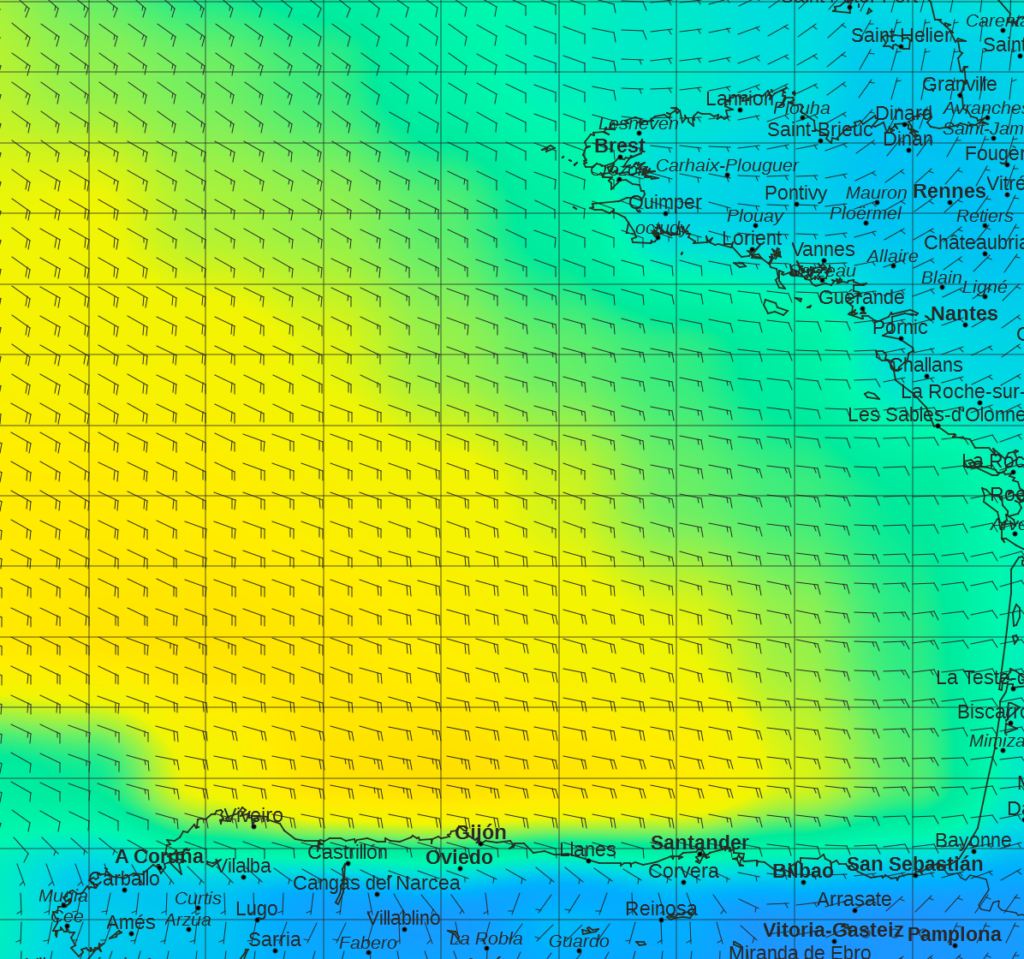
the forecast for our arrival at A Coruna.
The sea is quiet, and we see Belle-Ile slowly vanishing in the distance. We still have enough signal to receive a text message from my mom explaining she locked herself inside our flat while upgrading our lock. We will have to wait a few days to get the end of the story. We will spend the next couple of days with no comms whatsoever We just have an Iridium satellite phone. Data transfer speed, costs, the phone itself, everything looks like the pre-Internet era. We are alone, and we will soon experience the weird filling that there’s noone alive hundreds of miles around us.
The wind is weaker than forecasted, it doesn’t come from where it should, and we realize the 6 knots average we counted on might have been a little bit overestimated. Are we going to arrive saturday in a gale ? There’s not been a single passage in which we didn’t regret not going for a more conservative 5 knots target.
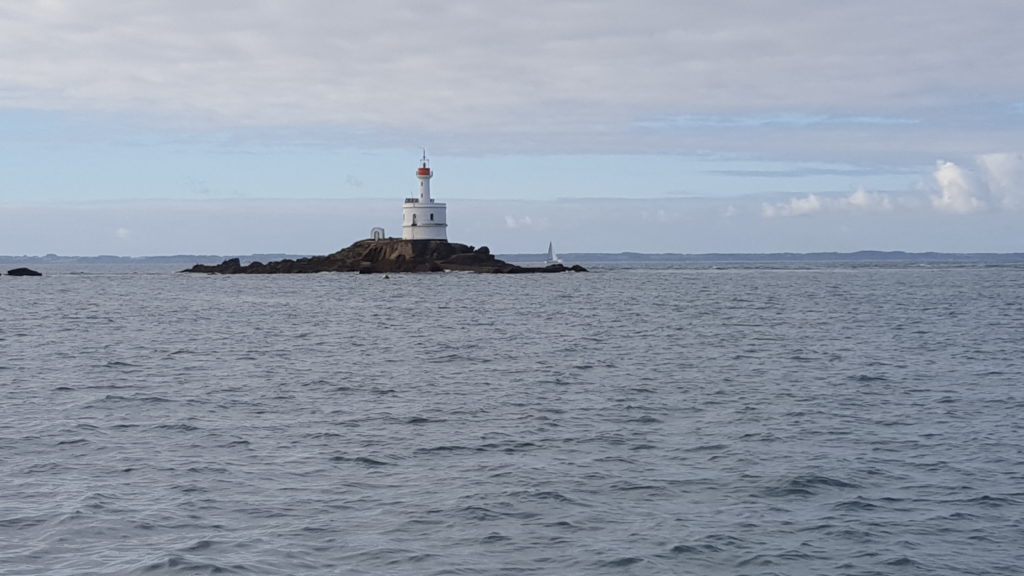
The phare de la Teignouse, we’re going to miss you, buddy!
The first night goes smoothly enough. We take turns sleeping, eat homemade pizzas, a lone dolphin hops in front of our bow, a small bird out of nowhere lands in our cockpit, the moon is almost full, and we’re heading right towards Spain. Suddenly, we’re cornered in the middle of a dozen cargos. Two hours later, they’re all gone. We must have crossed a shipping lane we weren’t aware of.
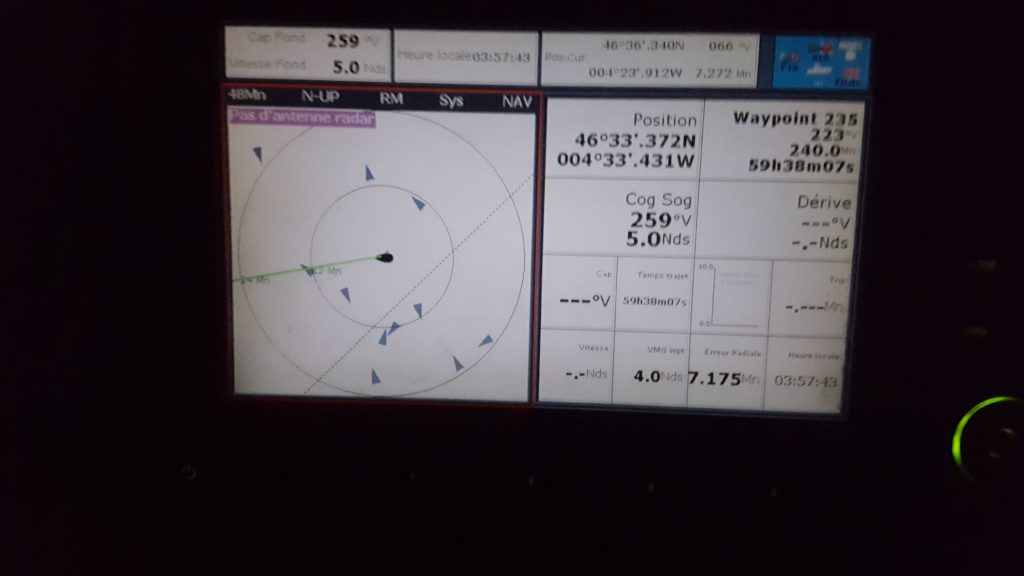
What a change in two hours.
The next day, we haul our spinaker, and it thrusts us over 9 knots. Sarah does even better than the autopilot and pushes our speed to 9.9 knots. With the evening, the wind picked up some strength and we’re back to our initial genoa / full main sail combination. Reducing our sail area for the night would make sense. Reefing is simpler during day time, and nobody has ever been in trouble for reefing too early. Worst case scenario, it will cost us a few miles. That’s Sarah’s viewpoint. We updated our wheather forecasts with our satellite phone, and the wind is not going to change until we’re in Spain, so I don’t think reefing is needed. Sarah acknowledges, as she’s to exhausted to argue. It is 9pm, and I’m going to sleep.
Midnight. I’ve been sleeping for three hours straight, and I’m starting feeling very comfortable in my bed. We’ve moved to the aft cabin, as it’s more stable than our usual fore cabin and also closer to the watch person. Suddenly, Sarah pours cold sea water in my neck; or at least that’s what I thought was happening. One of our hatches wasn’t closed properly, and a poorly timed wave made its way to my bed. Always, always close your hatches. I wake up, not in an ideal mood, and meets Sarah who intended to wake me up. “We need to reef”, she says. She doesn’t add “I told you so”, but I can see it in her eyes, and she’s not wrong. She just spent two hours battling with an overcanvassed boat to let me sleep.
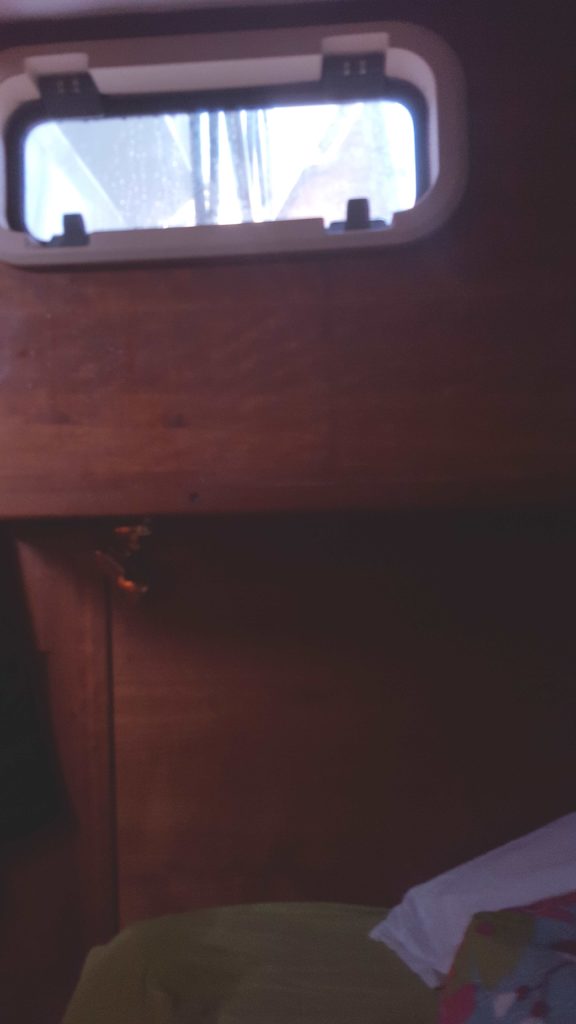
If you look closely, you can see where the water dripped along the wood and on my pillow. This picture is totaly useless, but I took it just in case I could use it to trace back the incident to Sarah.
The wind is much stronger now, 6bft with some huge gusts. Lucy goes into the wind every few minutes, and our Raymarine has a hard time coping. We don’t even dare trying the new pilot : we need to reef again. We roll our genoa, Sarah sets up our inner fore stay, which we should have prepared a long time ago, she installs our new smaller headsail, and we immediately pick up half a knot. Bringing the rudders kind of parallel to the boat is definitely a good thing.
Five in the morning. Sarah is sleeping. The wind is not weakening, and our wind-vane is turning as if there’s no tomorrow. The sea is now bigger, with a few 3 meters tall breaking waves. Of course, that’s when our Raymarine decides to display “no data” on its screen. I’m sure it’s the rudder angle sensor that disengaged again, but I can’t really fix it single-handedly with the swell. I switch to our auxiliary pilot. Shoutout to Antoine, Xavier, and every single person who told us not to leave without a backup.
I’m exhausted, but the scenery is breath-taking. I hand-steer under the stars, the sea is incredibly beautiful. Suddenly, the moon appears and floods it’s bleak light over the waves. I notice on the AIS that we’re following a 144ft sailboat, the Fryderyk Chopin. I would love to close in on her, but she’s 1 knot faster than us. I’m having a hard time staying awake, but I know I shouldn’t interrupt Sarah’s sleep. If I do, she’s going to take a one hour watch and wake me up right after – I should know, that’s what I did to her yesterday. I’m reading three month old newspapers on my tablet to keep my eyes open. Apparently, Trump is the Republican nominee.
10am. The wind is now 8bft strong. Huge gusts and breaking waves. Our secondary pilot is on strike. It engages allright, but refuses to move the tiller. A sailboat passes us with only its foresail on, and we decide to mimic her. Taking our main down probably took less than 10 minutes, but it felt like an eternity. Biging a sail down in a storm is never fun, but we should definitely have prepared everything before I leaved the cockpit. It’s hard to keep the boat reaching in a huge see without a pilot and while setting up an halyard. I ended up spending two minutes two meters above the deck for no reason at all. For the first time of the passage, I have been a little bit afraid, and I’m completely soaked, but the sail is down. We’re making 8 knots now, tthrusted forward by our small headsail. I feel adrenaline in my veins. I considered going to sleep, but I’m feeling completely awake now
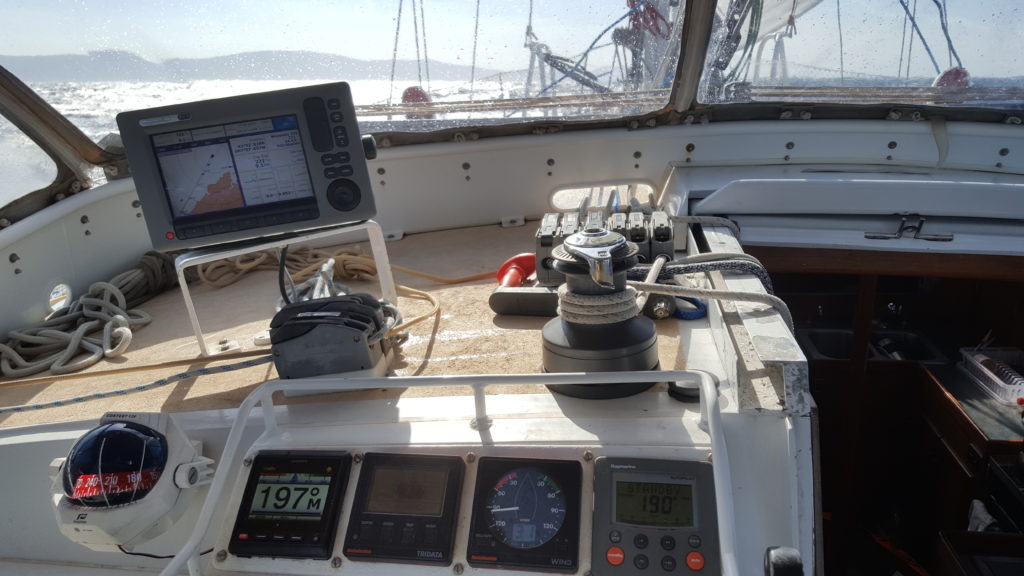
It’s hard to realize what a mess it is outside on a picture.
RIght as we pass Cabo Ortegal, everyting stops. It breaks the wind, and hence the swell. I take the opportunity to fix the Raymarine rudder angle sensor. The same thing happened to us last spring, but at the time the pilot could still steer. I have no idea what changed, but we should definitely have made a sturdier connection last time we fixed it. On a sailboat, if something breaks, it needs to be reinforced. We’ve read it multiple times, and it is starting to make sense.
Spain is know at our fingertips. We’re going along its cost, getting its signal, we can almost smell a tortilla flavor in the air. Adrenaline is long gone, but it has been replaced by an urge to arrive. I’m still awake. Tonight, it will take a hurricane to interrupt my sleep.
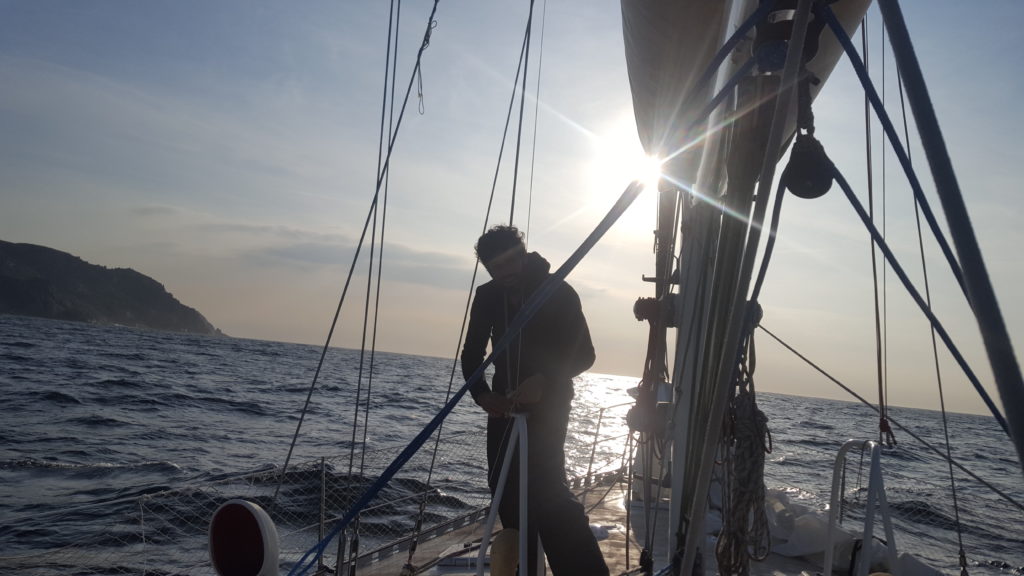
Me trying to haul the spanish flag (and Sarah, trying to take a picture against the sun)
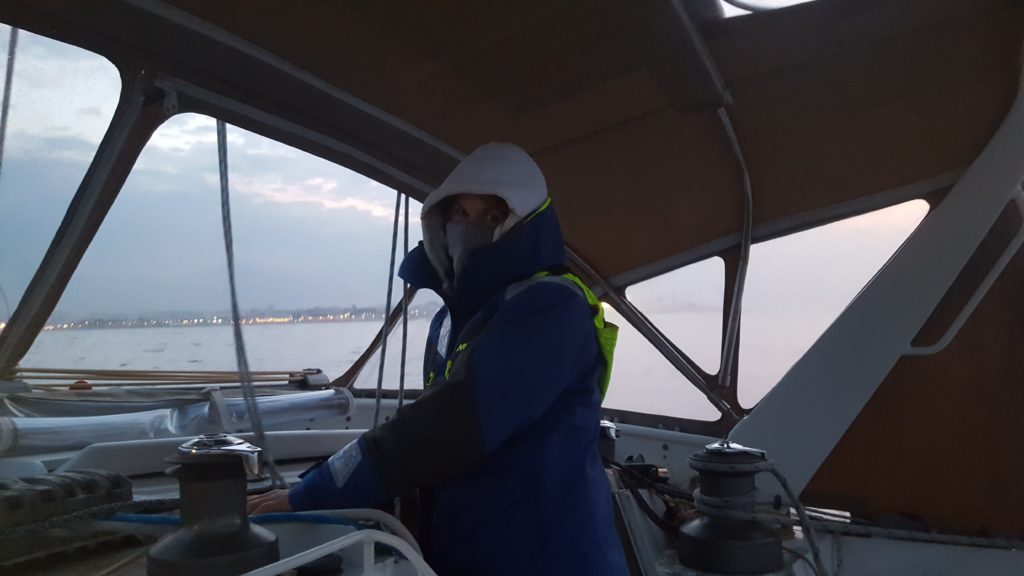
Things are going to run completely out of hand in cold countries !
It is 8pm when we arrive at A Coruna. Our average speed? 6.1 knots. Sarah uses her best spanish to call the marina on the VHF, and gets an answer in french. She’s too tired to take offense. Fryderyk Chopin is waiting for us, she’s a beautiful brick, meeting her at sea in the storm would have been a unique encounter. The harbour maneuver which would have been a headache six month ago is a piece of cake in such a large berth. We even treat ourselved with a warm shower before the building closes. Tomorrow, we will eat tapas in a lively street. For now, we’re going to bed.
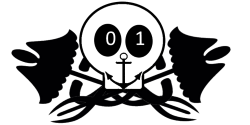
Waouh, vous progressez bien!
C’est l’aventure… et j’aimerais pas du tout être à votre place! 🙂
Exactement ce que je me dis à chaque fois que tu pars pour ta semaine de rodéo dans les Alpes 🙂
Je ne comprends pas tout à la partie technique. Mais vous avez l’air de vous débrouiller. Bon courage et prenez bien soin de vous.
Ps: si vous pouviez améliorer vos photos pour l’Islande, ce serait bien.
Oui on a décidé d’utiliser un vrai appareil photo au lieu de nos téléphones maintenant ! Pas sûr que les photos soient beaucoup plus réussies, mais au moins elles seront de meilleure qualité ! 😉
c est top ! Belle traversee !
A peu près aussi agitée que la votre il y a 2 mois si j’ai bien compris ! a très vite 🙂
Attendre des semaines les meilleures conditions météo pour traverser le golfe de Gascogne et, à cause d’un contretemps technique, partir en sachant que vous pouvez vous mettre en difficultés parce que vous en avez assez de la Trinité, hum ! Pas terrible les jeunes !!
Je vous envoie plein de bisous, régalez vous et restez prudents.
En fait la météo prévoyait une très bonne fenêtre ! Et même quand on a actualisé nos fichiers de vent au milieu du Golfe ils sous-estimaient de 10-15 noeuds au moins la force du vent… Et au final c’était inconfortable (à cause de la houle), mais pas dangereux du tout, et surtout plus rapide !! 😉